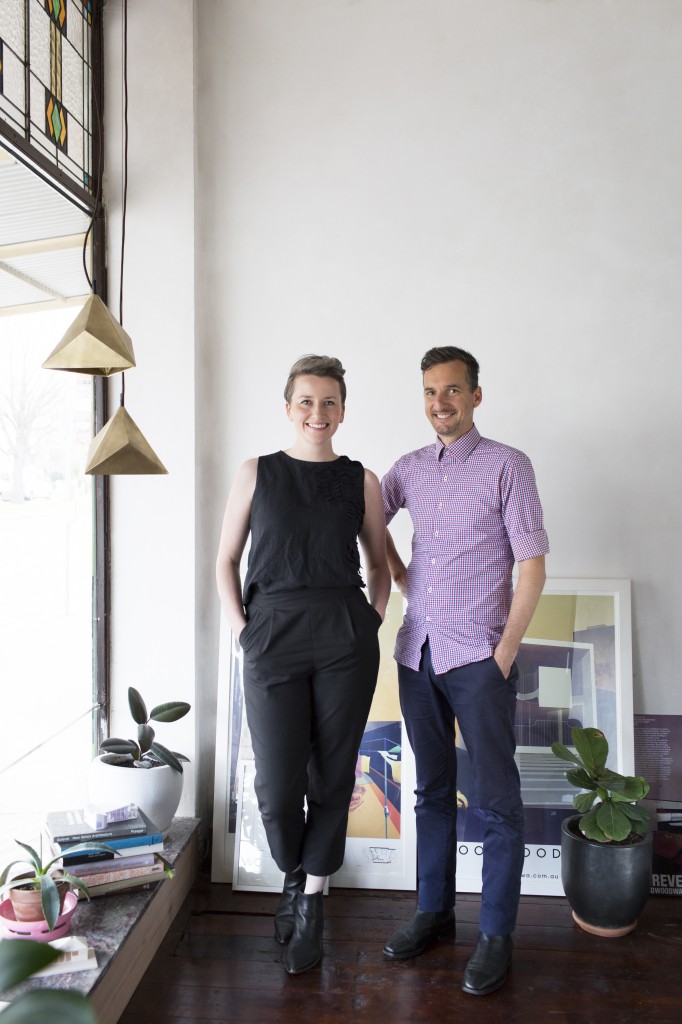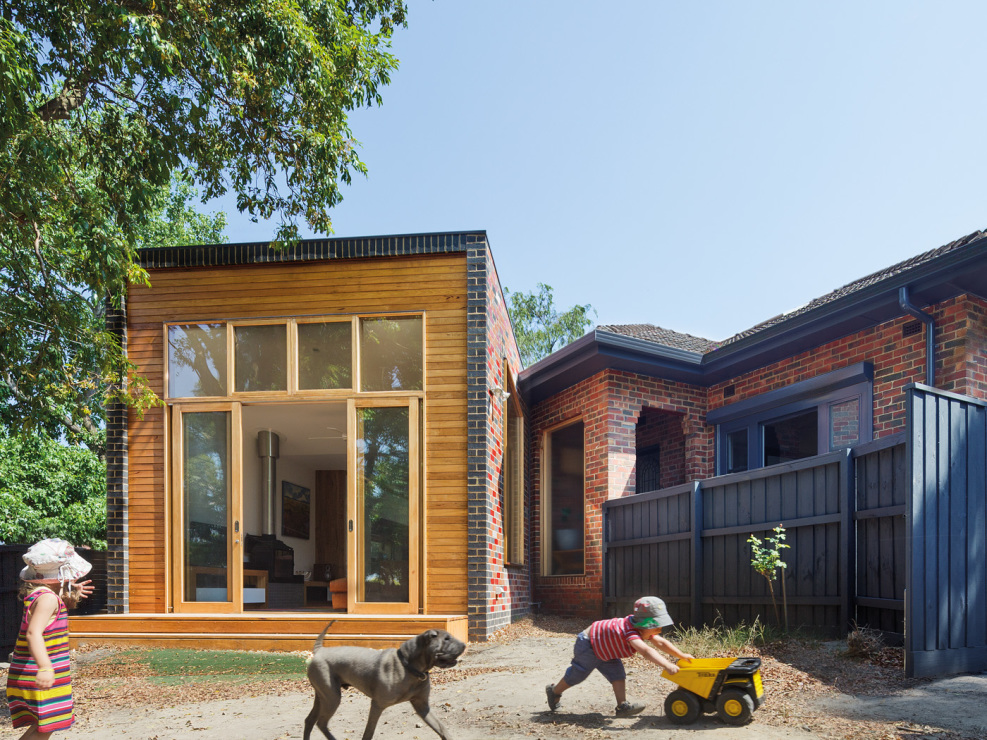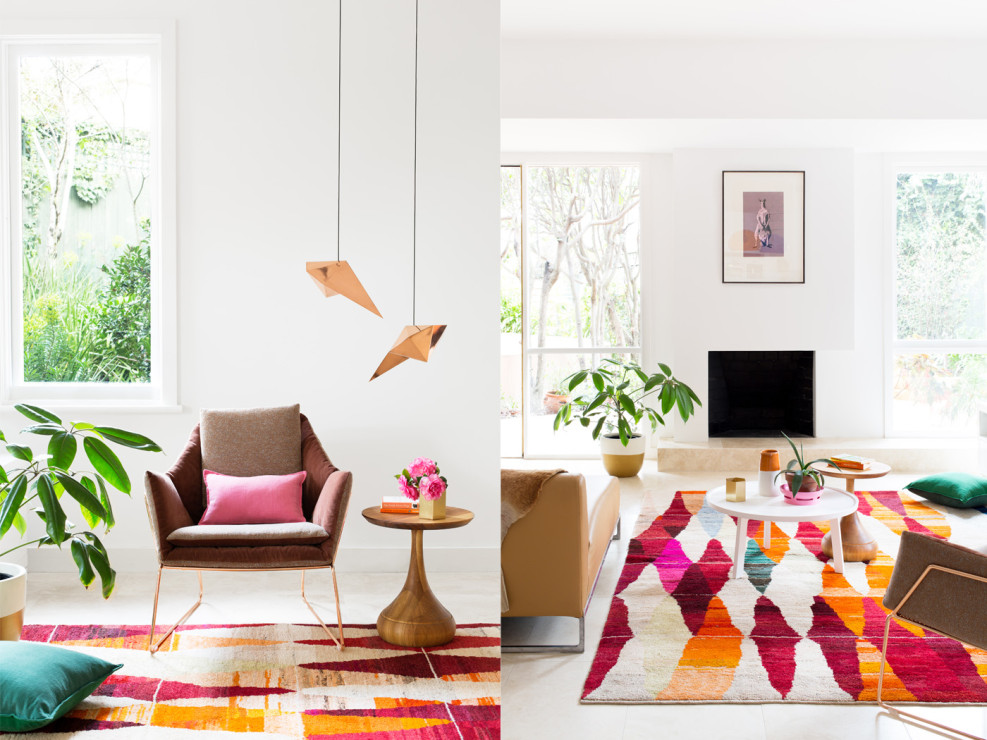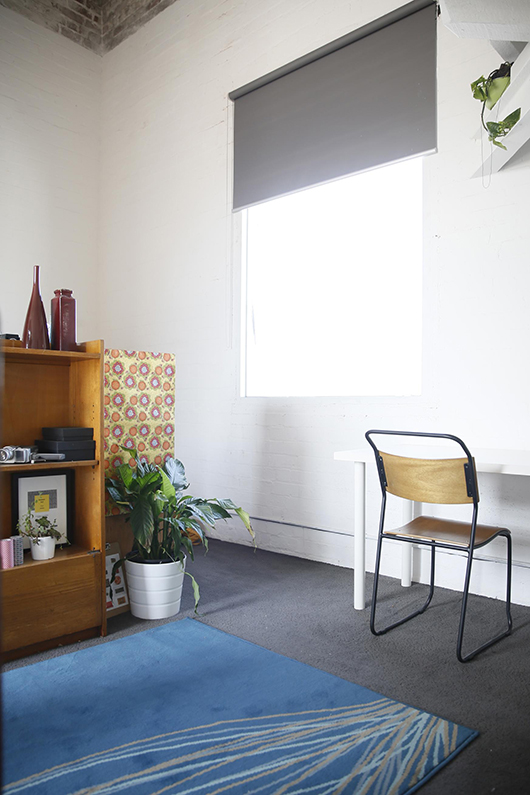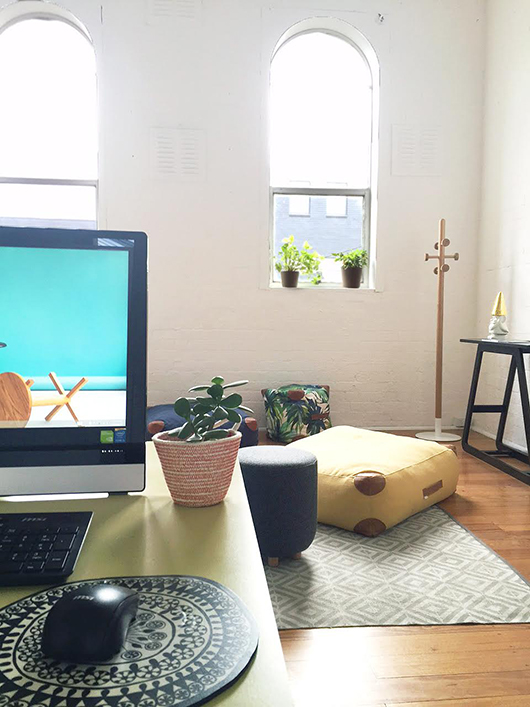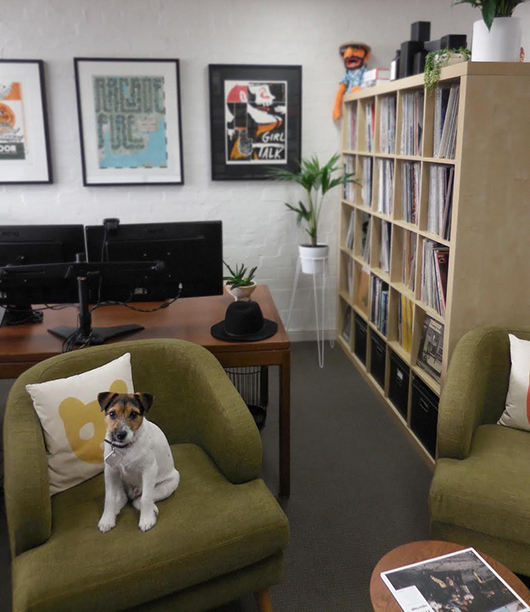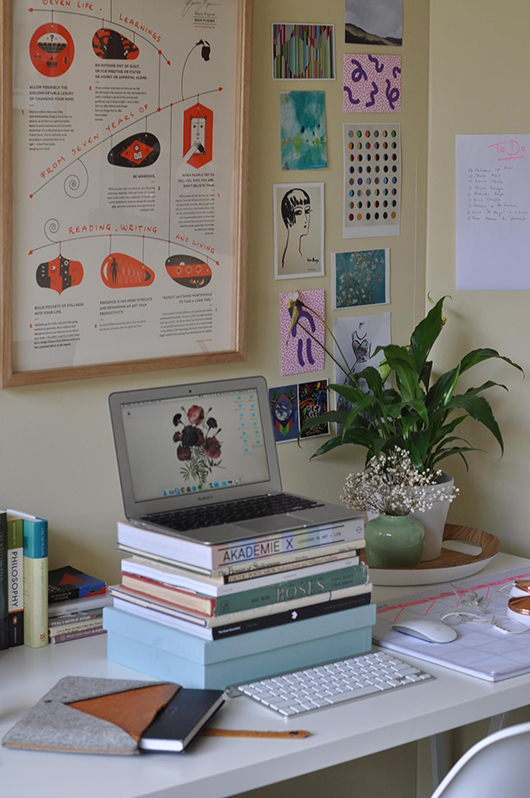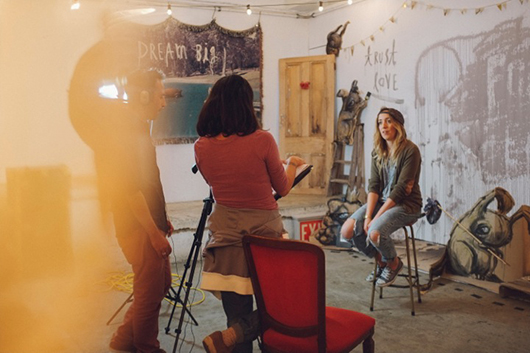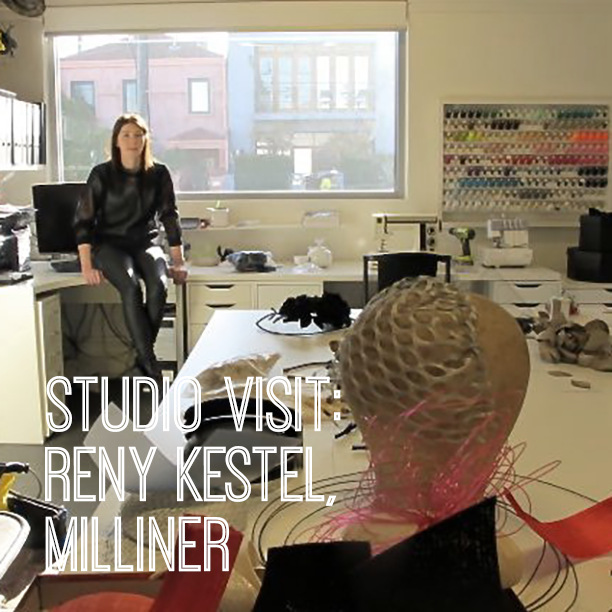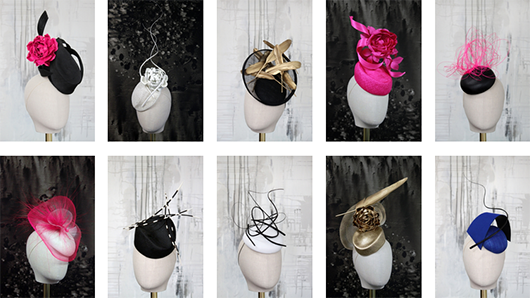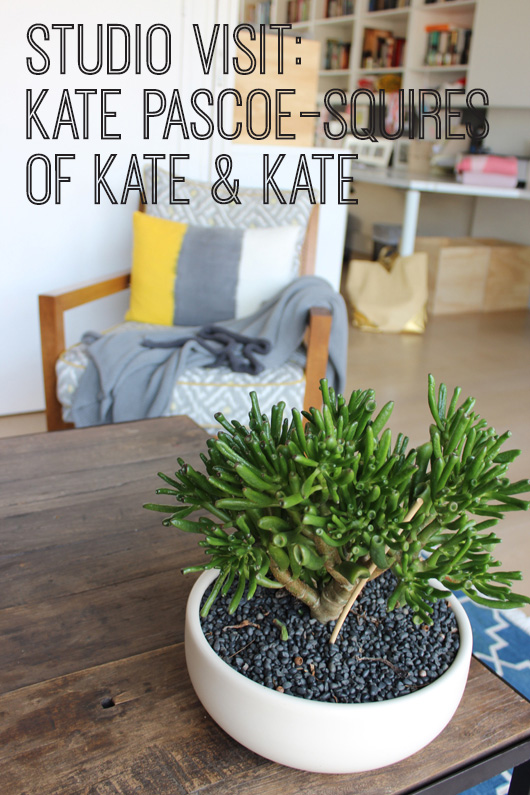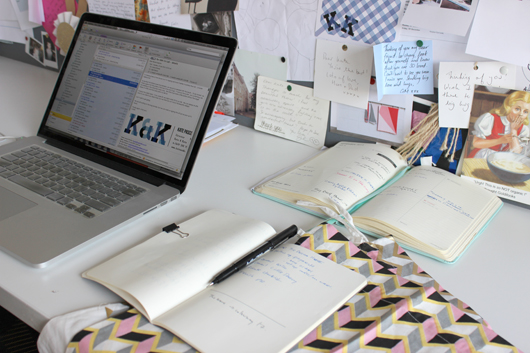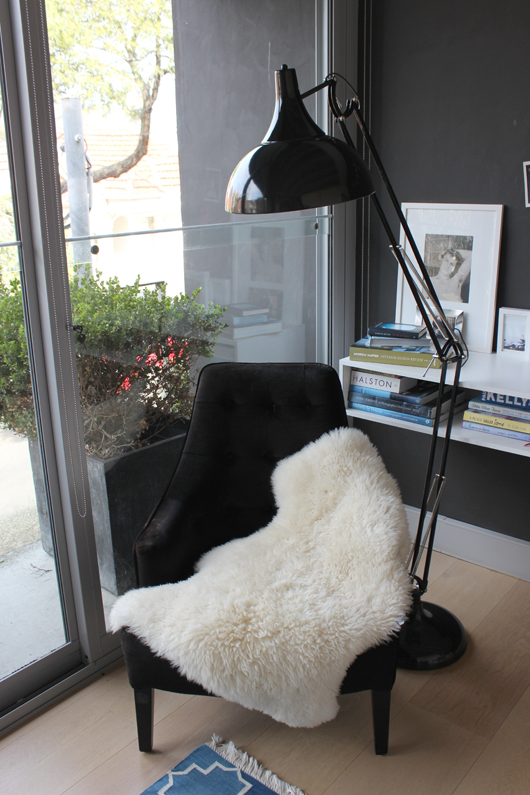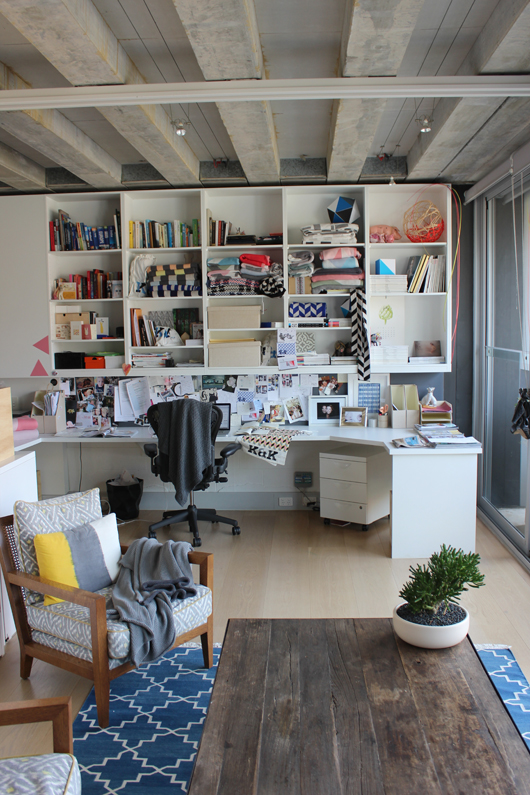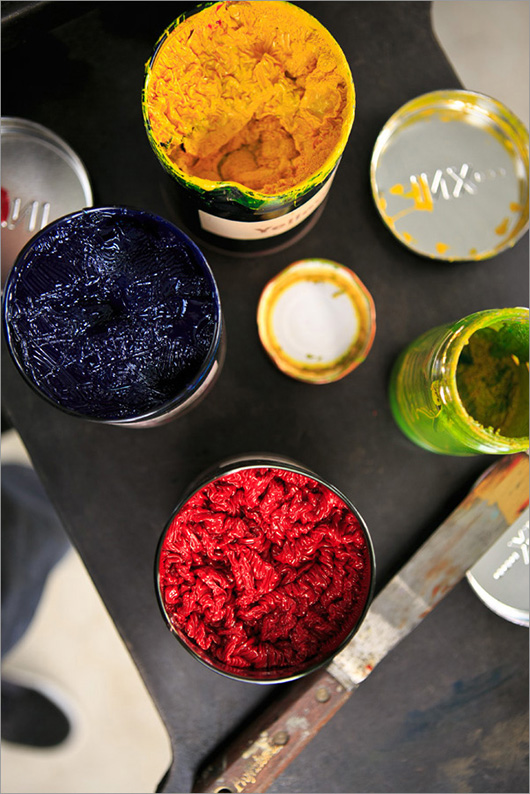Studio Visit: Monique Woodward, architect
 It’s not often on just hearing a name that you get such a strong sense of the dynamism behind a creative duo, but this is just the case with WOWOWA (implied!) whose co-founders Monique and Scott Woodward forge a next-generation approach to architectural practice with a kind of positive charge often missing in professional creative circles.
It’s not often on just hearing a name that you get such a strong sense of the dynamism behind a creative duo, but this is just the case with WOWOWA (implied!) whose co-founders Monique and Scott Woodward forge a next-generation approach to architectural practice with a kind of positive charge often missing in professional creative circles.
In WOWOWA Architecture & Interiors, the pair have created the kind of practice they always wanted to work in, one that prioritises artistic expression, teaching and advocacy as essential to ongoing creativity. Alongside partner Scott, Monique is a vocal advocate for improved living standards and accessibility of quality design as a tenet of modern Australian culture.
From their glittering Tin & Ed business cards to the bold glazed red brick façade of the Finn House, WOWOWA is unafraid of a playful nod to the kitch, and their declaration of a radical postmodernist style is one beautifully tailored to bring a fresh optimism to the architecture of the everyday – the humble family home. We spoke to Monique at WOWOWA’s shopfront studio in Melbourne’s leafy Carlton North about her passion for celebrating Australian culture and why more creatives should embrace the power of marketing.
As an emerging practice, WOWOWA has a strong brand and clear creative directive – what inspired that focus and how has it shaped the way you practice?
One of the biggest challenges we faced initially as a fledgling but ambitious creative practice was acknowledging that even if you were the greatest architect in the world, you need to be able to run a sustainable business to keep up that practice, and to successfully market yourself is a big part of that business’ success.
I undertook a marketing course at the local TAFE and we engaged a business coach, really immersed ourselves in marketing, read a lot of business and marketing literature alongside our favourite design journals.
We quickly realised that what we were saying to the world though our marketing - that we could do anything – was out of touch with the reality of our work at the moment. Whilst we do have a few small civic projects on the go and really enjoy the possibilities of larger scale projects, our current built reality is residential. Luckily, we love residential work, and it’s a big part of who we are as a practice, so it was important to acknowledge those roots and really emphasise its part in our core identity.
From this we developed a strategy that allowed us to focus in on the kind of clients we love working with – those who want to create their ‘forever home’. They’re committed to a place, and are prepared to do some soul searching, and explore what it is that they really want from a home environment.
Putting ourselves out there as a practice for professional families, with the tagline 'life is too short for boring spaces', we’ve found that people that subscribe to that will instantly recognise a kinship, and might know a little more of what to expect from us in the process. We can then work together and really bounce off each other in a super collaborative way. This makes the process a whole lot more enjoyable for both parties.
Image by John Gollings
How has this focus on creating a client’s ‘forever home’ influenced your work?
It gives us license to work with our clients in really rewarding creative depth, to find out what they think about colour, sculpture or pattern, and taking that through to find out how flexible and functional spatial solutions can work for them. I think that's one of our strengths, making small spaces work hard, and that's one of the reasons we love renovations, the challenge of really cranking up an existing space and making it truly multi-purpose.
Focusing on the small scale also allows us to really immerse ourselves in the application of the theory and art of creative practice. One thing is I’m a massive sucker for ornament. Ornament, in its three dimensions, really changes the way you perceive a space, and I think that's when a space really starts to get interesting.
What is your motivates you creatively?
My all-time favourite design inspiration has to be the humble Hills Hoist – there is so much ingenuity and kitsch beauty in perhaps undervalued elements of Australian design history that are ripe to be to explored creatively.
We see ourselves as a radically postmodern practice, propelling ideas forward to a new audience. Current trends suggest people are trying to revert back to modernism, and I find that quite unnatural, to be attempting to wind the clock back, and instead of creating spaces for living now, there is this tendency for blank spaces and miscellaneous design solutions; a blank floating shelf, a picture window to a non-descript view.
Society is always moving forward, and new technologies challenge the idea of the modernist home. We pride ourselves on not getting caught up on finicky modernist details but still having a very deep focus on embedding meaning in the quality of the interiors we create. We don’t necessarily prescribe what kind of curtains you should have, but we demand a high level of client engagement, that is often so rich that at the end of this day you can guide each other to the best solution for that space.
The nature of the construction industry means design and building programs can often stretch out over several years - how do keep up the creative energy between both clients and yourselves throughout that process?
From the very outset, we ask that our clients engage heavily in the design process, usually starting with inspiration scrapbooks, a simple cut and paste! Often in a 50c book or using sites like Pinterest, we get them to collect things from all kinds of sources, not just completed projects in design magazines. We want them to let us in on who they are, and the more information they can give, the greater depth of engagement we can have and the better the project outcome will be.
From a practice point of view - Mel (Bright) spoke at a recent AIA women's day breakfast about how there’s only really been three cycles of work in her ten years of practice, which is I think is an experience shared by many architects. It feels like we're about to hit our second cycle, which makes it exciting to see the development in our work and be proud of what we've achieved so far.
Image of Kooyong apartment by Martina Gemmola
How have you tailored your practice to allow ongoing teaching and community advocacy commitments alongside your design projects?
From the outset we wanted to create the studio that we had always wanted to work in, and one that would allow us to grow into as a practice. A lot of questions arose of what was important to us as a practice; it's collaborative, its deep in discussions, surrounded by plants, and embedded in the local community. We work fairly solidly from 9.30-5.30pm, respecting the workday, but recognise that we while could work till 10pm, it comes back to practicing what you preach - you can’t advocate to increase the standard of living and then work yourself to the bone in the process.
It means we’re able to maintain a lot of energy in the studio throughout the day, which is slightly more optimistic than spending half an hour on The Age website at midday then having to work late into the night. I’m reading managerial books and trying to look beyond being just technically good at what we do, because that doesn’t mean we're necessarily good managers or business owners, but we can be, so it's a skill that needs to be learned side by side with design.
We also implement 'cultural Sunday' which is to make sure we do something that a) recognises it's important to make time to experience new things to keep that fire of creative inspiration burning and b) can be instagrammed, so yes, we’re always looking for the marketing tool!
Keely Malady is a graduate architect living in Melbourne. Keely’s blog, Small Talk & Co. aims to hold a space open for a new conversation on the wonders of work, and all the small things that make up a life well lived. Follow her on Twitter, Facebook and Instagram
Studio visit: Kelsie White of K Gets Organised
 Kelsie White packages a new set of cards in her home studio in Northbridge, Perth.
Kelsie White packages a new set of cards in her home studio in Northbridge, Perth.
By Kristen Marano
Kelsie White is changing the stationery game with her cheeky sayings and fresh designs. Her cards challenge the need for an occasion to send a sweet note with lines like ‘You’re my favourite blanket stealer,’ and her sleekly-designed paper pads encourage people to make to-do lists they’ll actually fulfil.
White’s childhood enthusiasm for stationery kick-started her paper goods business K Gets Organised in 2014; she has since created a collection of more than 100 products that fuse black and white sleek typography and cheerful watercolour designs such as popsicles and doughnuts.
At only 23 years old, White is a creative woman on the move who is constantly connecting and creating. White designs and packages in her bright sunny studio in the hip neighbourhood of Northbridge, Perth, sells her paper goods at local market stalls, and keeps learning as she completes her graphic design degree.
White is also the event host of the Perth chapter of Creative Women’s Circle, and she will launch the second event of the year this week. We recently chatted about how she got her start in stationery, her creative process, and where she plans to take her business next:
What attracted you to paper goods?
I'm what I affectionately call a stationery addict. I also love a good card stock, a hardbound notebook with the perfect paper inside, and writing out my to-do list every day. There is nothing better than sending and receiving a hand-written note from someone. The nostalgia and old world charm of stationery and hand writing, from getting your pen license to writing your wedding vows, really brought me to stationery; it has made creating and designing for special, heartfelt moments so beautiful.
Take me through your creative process.
I usually draw from a real life experience. My favourite yellow water-colour card reads, 'You're just so bloomin' lovely', and I made it with my beautiful girlfriends in mind. I was studying and working as a florist at the time and loved giving them little left over flowers from my shifts. That’s how I created the card.
A lot of my illustration work also comes from people around me. I recently drew some lovely popsicles for a local business called Delish Ice. I love the owner Katie and I’m so happy to have her as a friend; it was so much fun to draw happy little popsicles while thinking about her passion, drive, and kindness.
I also love to draw from current trends; my latest planners feature doughnuts, indoor plants, and popsicles.
Sketches, and water-colour designs mark White’s studio walls as inspiration and new works in progress.
What puts you in the mood to create?
A great cup of coffee, a beautiful cafe, and Wi-Fi. With all of these things, the world is my oyster.
You're successfully running your own business at such a young age. Who has influenced and inspired your journey as a small business owner?
I really wanted to be my own boss and push myself to try something new. I had never studied business or run a business before.
I've been studying art and making art since I was very young, and I wanted to get back into creating while I was at university; I started making planners to help motivate me to complete my assignments. From there I launched a tiny collection of five planners and now have more than 100 products under my belt. This was not an easy journey, but it is by far the thing I’m most proud of doing in my life.
My role models include Anna Rifle Bond from Rifle Paper Co., who I was lucky enough to meet in London last year at a stationery conference (they exist!), and Sass Cocker from Ask Alice in Melbourne. They both really inspired me to go out there and create beautiful paper goods.
What can we expect from K Gets Organised in the coming months?
A really big and exciting change that will launch around February 2016.
In December, White will depart for a creative getaway through Europe and the United States. To follow her journey and get regular behind-the-scenes posts, check out her Instagram.
Kristen Marano is a digital nomad living in Perth, Australia. Kristen interviews women in business. She contributes to Huffington Post Canada, and produces a weekly newsletter, Creative Women Weekly, featuring stories of creative women from around the world. Follow Kristen on Twitter @kmarano.
Five creative workspaces
Following my previous post, how to design your own creative workspace, I set myself the task of answering a few questions about creative women's workspaces: What is the ideal workspace? Are there any similarities between the workspaces of creatives in different industries? How do others personalise their work space?
Through The Circle Database, I found five CWC Members from varying industries and asked them to share some details of their own workspaces. Here's what I discovered...
The Photographer
Elizabeth Bull owns and manages One Fine Print, an business that collaborates with talented photographers to bring unique, bold and distinct photographic prints into the home.
Describe your workspace (or spaces) in five words. Industrial - Creative - Light - Productive - Fun
Do you have more than one workspace? Occasionally, just for a change of scenery I'll work from home or if I'm finding I'm getting stuck on something, I'll wander to my local cafe with a note pad and work from there for a while. I usually find the change of scenery and the walk helps get the creativity flowing again.
How have you personalised your own workspace? Many big beautiful bold photographic prints, timber desks, old cameras, greenery and a hammock!
Do you share your space with anyone else? A partner, pet? We are attached to a communal warehouse which houses many photographers and designers. We love being part of a community of creatives.
What are your essential ingredients for a productive but engaging workspace? I've worked from quite a few spaces, and I've learnt that the most important thing for me to look for in a space is natural light and big windows. That combined with great people makes for a place I want to work from every day.
The Florist
Meghan Fletcher, floral designer for weddings and events and director of her own business, Good, Grace and Humour.
Describe your workspace (or spaces) in five words. Homely - transient - innovative - tuneful - fragrant.
Do you have more than one workspace? The majority of my work is completed from home. But, if it counts, I would consider my second workspace or 'workspaces' to be the venues I install into for each event. I take along my tool kit and set up and pack down in some fantastic spaces.
How have you personalised your own workspace? For now, my workspace at home is transient so it's difficult to create a permanent workplace personality. My home needs to be functional for my family at the end of each day, so arrangements and tools need to be stored so they're not eaten by my toddler! If I were to separate my workspace from my home, as is the plan in the near future, I suspect the personalities would be similar - I'm a sucker for colour, abstract art and clean lines.
Do you share your space with anyone else? A partner, pet? Home and work can often be a colourful and collaborative coexistence. I share my space with my husband, our son and our cat. Part of the house is dedicated to storing GG&H items. One room used to be big enough for me to work in and store items, but as GG&H expands, I've had to become more innovative with storage and workspace solutions. Not that my husband or son seem to mind eating their brekky while I bring flowers into the kitchen!
What are your essential ingredients for a productive but engaging workspace? In my case, being able to balance work and home life with storage solutions, comfortable and waterproof (!) workspaces, and efficient and sustainable set-up and pack-down practices, along with a nice place to sit with the laptop and a cuppa. I'm hoping to have a permanent studio space for next season where I can incorporate all of these really practical elements, along with the little personal touches that permanence encourages.
The Furniture Maker
Anne-Claire Petre is a furniture designer and owner of her own business, Anaca Studio, which offers a range of furniture and accessories with a focus on using responsibly sourced timber and other sustainable material and finishes.
Describe your workspace (or spaces) in five words. Light-filled - uncluttered - inspiring - green - zen.
Do you have more than one workspace? I have one studio where I work from when I'm not doing pick-ups or visiting clients. However within this, I have two "workspaces", my main desk where I do most computer work and drawing / sketching and another desk for anything requiring assemblies / cutting / finishing or sewing / "crafting" at times…
How have you personalised your own workspace? I have only recently move into my Collingwood studio, so unfortunately I haven't yet done much in the way of personal decorative arrangement… Except for my little golden hatted gnome from Hunting for George which makes me smile… Walls are in great need of some artwork!! But to make up for that I have brought in quite a few plants and adding to the collection fairly frequently! Never enough green!
Do you share your space with anyone else? A partner, pet? No, it's just me and the gnome! Until recently, I was working from home so my two gorgeous cats were my companions, although quite distracting at times! The studio is part of a complex of other artists and designers so I always bump into other fellow creatives at some point in the day, which is nice. It gets a bit boring being in your own head for too long!
What are your essential ingredients for a productive but engaging workspace? For me, cluttered space = cluttered mind. So I try to keep the space as tidy as possible. Every night before I leave, I do a bit of a tidy up, feels so much better when you get in in the morning. I also turn on the music and plug in my essential oil diffuser. Plenty of natural light is key. That's what got me when I first visited the studio - massive windows and height ceiling… It felt really inspiring. Quirky objects are also essential to light up the mood!
The Lawyer
Yasmin Naghavi is a solicitor at Media Art Lawyers, a boutique entertainment and media law firm.
Describe your workspace (or spaces) in five words. Not - a - corporate - law - firm.
Do you have more than one workspace? I mostly work at my desk but also use the boardroom and meeting areas downstairs when I’m meeting clients. I sometimes meet clients in their workplace, but the majority of my work can be conducted by phone and email. I also get the opportunity to work from our Sydney and Auckland offices from time to time which is always a refreshing change.
How have you personalised your own workspace? Mostly by bringing in plants, records, posters, books and a couple of comfy armchairs – I wanted the space to feel like my living room. Our space was initially just one room, but we added a bookshelf to store our vinyl records as well as act as a bit of a room divider. If I had my way we’d change the lighting, because fluorescents are just plain sad. Luckily we have a huge window above the stairwell which means we get heaps of natural light and a view of the treetops in front of our building.
Do you share your space with anyone else? A partner, pet? Well, there are up to 12 people in the building on most days but the type of work we do is very autonomous so we spend most of the day at our respective desks. I work on the second floor with one of the partners of the firm (who also doubles as my husband) and our dog, Wilco (pictured). Wilco prefers to conduct his business outdoors.
What are your essential ingredients for a productive but engaging workspace? Communication is always key to an effective workspace, but so is working with people you respect and colleagues who have a quick wit (you need a sense of humour in this line of work).
The Writer
Madeleine Dore is an arts writer and editor at ArtsHub by day, and in her free time, runs an online project called Extraordinary Routines, where she interviews creative people about their daily lives - from what time they wake up in the morning, to their views on life and creativity.
Describe your workspace (or spaces) in five words. Filled - with - to-do - lists.
Do you have more than one workspace? For my day job I work in a city based office, but have set up a desk in my share house to work on Extraordinary Routines. I also have a fondness for sitting in cafes – one of my favourite places to work is John Gorilla in West Brunswick. They have this adorable little nook by the window, which is perfect for just one person. Also Moat (below the Wheeler Centre) and £1000 Pound Bend are great places in the city.
How have you personalised your own workspace? I recently got around to framing a watercolour by illustrator Monica Ramos and a beautiful embossed poster created by Maria Popova of Brainpickings - my favourite website. It’s nice to have something beautiful to stare at in those moments of absent-mindedness and distraction! I also like to collect cards from exhibitions and have them dotted on the wall. I’m not very good with plants, but have managed to keep a Sweet Chico alive for a month now, and so it has been nice to have some greenery on my desk. I also have a giant desk planner from Kikki K and I’m addicted to writing to do lists and pinning them around my desk.
Do you share your space with anyone else? A partner, pet? My desk is set up right beside my roommate’s identical IKEA trestle desk, so we often sit side by side in the evening working on our projects. It’s very cosy, and nice to have company when you’re working into the night!
What are your essential ingredients for a productive but engaging workspace? Even though my mind works best when I’m working on something individually, it really helps to have other people around me – if I can see them working, it motivates me to get cracking on something instead of just scanning Facebook! In the absence of people, there’s always Spotify. I really like having my planners, diaries, and lists nearby so I know what tasks I have ahead. Similarly, I don’t like clutter, and often need to neaten my desk before getting onto the task of writing. As I writer, I also think it is really important to make sure your screen is at eye level to avoid hunching – I stack my laptop on books and use a remote keyboard. Natural light never goes astray, too!
Interior Designer, Diana Scully owns and operates her own interior design firm, Spaces by Diana that’s all about designing beautiful, personalised homes to reflect the people who live in it. Diana also has her own lifestyle blog, Spaces + Places, where she regularly writes about inspiring spaces to see and visit from around the world and shares her recent travel adventures. This year she has plans to spend time abroad in the US. Follow Diana on Facebook,
Studio visit: Hayley Welsh, Street Artist
By Kristen Marano
Perth Street Artist Hayley Welsh works out of her home garage, but there’s nothing garage-like about it. Welsh has created a space that reflects every bit of who she is: a street artist, traveller, and family person.
Travel trinkets—mostly American flags from her school bus project —adorn shelves; colourful patterned rugs keep out the cold, and a refinished wood grain table lines the back of the room. Welsh has neatly organized a corner of paintbrushes and paints; vintage picture frames lay stacked on the floor, and the main garage wall is covered by floor to ceiling canvas and butcher paper for Welsh to sketch and paint on.
I met Welsh at her exhibition Hijacked, a collaboration with her partner and Photographer Andy Faraday. We recently caught up on a Friday afternoon to chat about her creative process, and how travel has influenced her work…
Describe the process of developing Hijacked and your choice of materials.
The whole thing was about seizing control of the situations that come to you and try to make the best out of things. It’s a belief that both Andy and I mirror in our work: try to seize what’s happening in your life.
I guess I looked at things I had been collecting, the ones that spoke to me that I could use to portray this ‘hijacked’ message. I had a collection of articles I was going to work on; Andy had been shooting his work in film and developing it. So, before the show we sat down, and I looked at works that Andy felt like that he would be happy for me to work on. I talked about pieces that I could see something happening. We wanted to create a show that we’d like to go see: sculpture, installation, a mixture of stuff and experiences. We tried not to make it a clinical and typical gallery space and more of an experience.
Describe the moment when you knew you wanted to create an exhibition about fear.
I was kind of dissecting what I was already creating. Figuring out what was I making, and what these creatures were. I realized it was all this recurring self-doubt.
When I held, Not You Again, which was a show about dealing with self-doubt, I read a book called, There’s Nothing Wrong With You. It was about how self-doubt and fear spreads to you from an early age. I thought it was interesting, and it explained a lot about why I feel the way I do. After reading that book I felt inspired that I wanted to explore that feeling.
How do you use this space to create?
I’ve been painting portraits a lot, and using this mirror to draw my reflection. My mood changes a lot in this space, and this wall can dictate the mood I’ve been in.
I don’t come into the studio until I’m ready to paint; I never enter the studio before lunch. It’s always messy before a show. Everything is pushed to the side, and everything I want to shoot is on the floor. “I’m always jumping from my computer to paint,” Welsh says with a laugh.
How has travel influenced your work?
Travelling is such a massive part of feeling empowered and meeting new people. I find you just get richer and richer in your experiences; you broaden your mind so much more. I can’t imagine my life without having travel being a big part of it. Travel has given me the kind of confidence to keep challenging myself, and keep stepping out of the comfort zone. We create better things when we are challenged.
That’s what I found with the school bus project a year ago. We had a show organized in New York, and we didn’t have the work for it. We decided to create the work while we were there. We bought a bus on the west coast, travelled to east coast, and I found whatever objects. I had a lot of self-doubt like what am I doing with my life? Why are we in a bus? But, I loved every second of it. All these emotions created that body of work.
What’s next?
Welsh had told me, “My dream would be a warehouse where I can relax, invoice, do admin stuff.” Maybe her dream is about to be fulfilled. Welsh and Faraday will soon host Not Another Open Studio, an invitation to join the duo in their new studio and see their new work in progress. Visit www.welshandfaraday.com to follow what they're creating.
{Title photograph by Kristen Marano}
Kristen Marano is a writer living in Perth, Australia. Kristen interviews women in business and writes about workplace culture. She contributes to Huffington Post Canada, and produces a weekly newsletter, Creative Women Weekly, featuring stories of creative women from around the world. Follow Kristen on Twitter @kmarano and Instagram @krismarano.
Studio visit: Reny Kestel, Milliner
Perth’s fashion scene continues to emerge, and Millinery Designer Reny Kestel is one of the city’s talented designers at the forefront of this movement.
Reny is a young and inventive hatmaker in a competitive industry that got its start in the 1800s. She designs and produces hundreds of headpieces a year for weddings, horse races and fashion weeks that range from edgy wearable art to classic and elegant hats, leather headbands and hand-beaded combs.
Reny, a Perth native, set up her studio and gallery two years ago in the city. Previously she was living in London, England, where she also discovered her interest in millinery.
Some might expect that attracting customers outside of Australia’s most isolated state might be difficult, but Reny’s future-thinking designs and respect for tradition keep her top of mind among a diverse customer base. Women rely on Reny to make custom hats for big racing events of the year like the Melbourne Cup and ongoing regional events throughout the country. She currently designs headpieces for Alana McLean, the face of WA Country Cups.
I visited Reny's Perth studio to ask her about her designs and learn how she stays relevant.
How did you get started in millinery?
I was going to Royal Ascot, and I must have spent hours in this small pokey shop looking at all the trimmings and hat blocks available. This exploring led me to inquire about millinery classes, and from there I have never looked back. I’ve fulfilled my vision by returning to Perth and launching my own label.
It’s kind of an ironic path as I’ve been fascinated with birds from a young age. In fact, I wanted to be an ornithologist when I was 12-years-old. So, it’s nice to be able to work with bird feathers.
 Reny Kestel works on a headpiece in her studio, one of hundreds she produces every year.
Reny Kestel works on a headpiece in her studio, one of hundreds she produces every year.
I have also always had a keen interest in art and design from a young age, and I continued this interest by studying Fashion Design at Central Institute of Technology in Perth. I love the idea of wearable art, and fashion is a great form of self-expression. The 3D shape in art and sculpture, and designing with patterns from flat fabrics has always been exciting.
How have you set up your space to help you be productive?
Being organised is definitely key. I need to have materials that I use frequently, easily accessible and colour coordinated so I can grab them with minimal fuse.
My other essential items are clearly positioned in the right workspace areas, such as millinery wire on hooks with tape measures and wire cutters hanging next to them. I have two large steel rulers fixed to the large central table, so when I need fabric straw materials or Petersham ribbon I can quickly measure the exact amount and be able to note the amount I use.
I always go by the rule that everything has a home. My materials are arranged and labeled so I know with a quick glance what I am looking for. I try to clear the workshop table space every few days or weekly, and put things back in their place after an artistic explosion. I find I can’t get into a creative mode and think clearly without using a clean space.
 Reny and her father created this thread spool holder to make her material easily accessible and keep it organised.
Reny and her father created this thread spool holder to make her material easily accessible and keep it organised.
What's your biggest creative fear and how are you overcoming it?
Not really fearful, but I’d call it…creative pressure – that is balancing my creative time with the general operations of the business, which involves emails, calls, sales, bookwork, administration, public relations and social media.
I also have to ensure that the time I spent creating each piece aligns with the price of the piece. This can create a bit of pressure to get things made within a certain time period.
 A leather headband in progress on Reny's work table.
A leather headband in progress on Reny's work table.
How does living in an isolated state help and/or challenge your business?
Since the whole Internet revolution, I don’t notice how isolated Perth is anymore. Connecting to people, finding inspiration, and material sourcing is not a problem now.
Perth’s population is small, so it does help in terms of networking. We are lucky to have a strong supportive fashion industry in Western Australia, and I think this is because the state is so isolated.
One last question…
At the end of our visit I asked Kestel if she has attracted any North American clients yet, where I anticipate her designs could catch on. “Not yet,” she said, but one thing is certain, Australia is lucky to have a defining homegrown designer like Kestel.
Follow Reny’s designs and shop online at www.renykestel.com.
{Studio images by Kristen Marano}
Kristen Marano is a writer living in Perth, Australia. Kristen helps companies build relationships with their audiences through compelling content programs. She also shares her fashion and lifestyle perspectives with Huffington Post Canada, and produces a weekly newsletter, Creative Women Weekly, featuring stories of creative women from around the world. Follow Kristen on Twitter @kmarano and Instagram @krismarano.
Studio visit: Kate Pascoe Squires of Kate & Kate
Kate & Kate is run by Kate, and well, Kate. Not only do the two share a name, they are also business partners, sisters-in-law and best friends and they share a passion for blankets!
Launched almost one year ago, Kate & Kate offers beautiful blankets knitted from super-soft, breathable cotton. The business is run from the Kates’ homes in Melbourne and Sydney.
Recently, I had the privilege to visit Kate Pascoe Squires in her Sydney home studio which was formerly an architects office. The space, which Kate shares with her husband, is filled with light and has a lovely view over the rooftops of her Bondi neighbourhood. She shares more with us below.
What is your background? How did you arrive at Kate & Kate?
I studied public relations at RMIT University in Melbourne and jumped straight into the industry. I focused on all the fun stuff - food, restaurants, providores, wine, spirits. You get the idea. It wasn’t until I had my second child that I realised the PR lifestyle was just too much of a juggle for me. I was definitely ready for change. I wanted to do something creative, something tangible. I just can’t believe that blankets were my calling!
(The other) Kate’s background is fashion. She has worked across all sectors of the industry - retail, production, design and wardrobe, she did it all. Like me, she realised once her first son was born, that working in wardrobe was not going to work. The hours were ridiculous.
We were both looking into separate individual pursuits when we came across our manufacturers. Within half an hour, it was decided – we would go into business together and blankets would be our thing.
What do you think makes for a creative working space?
Both of us do most of our work from our home offices. Our work and personal lives are so intertwined and our work spaces really reflect this. We have to work to keep creative, but that’s what makes this whole thing so amazing.
We do find that getting away together really boosts our creativity. We don’t get to do it as much as we’d like, but we take what we can get! Our trip to India at the start of the year was incredibly inspiring – we are still working on designs based on the inspiration we pulled from that trip. Where to next? I’m saying New York… but we’ll see.
Describe a typical day for you.
Wake up or get woken. Serious Instagram scrolling. Emails. Mental plan for the day ahead. Corral the kids downstairs. Husband too. Shower. Vortex of getting kids dressed, serving breakfast, school lunches, packing bag, screaming for everyone to get out of the house and school drop offs. More emails. Design. Inspiration. Liaison with our manufacturers, retailers, stylists, media. Phone calls. Emails. Pilates. Kids, food, wine. And repeat!
You have just launched the Kate & Kate baby range - what lead to this?
We had customers and retailers asking for them! The fact that Kate was pregnant at the time we were designing didn’t have anything to do with it - ha ha ha! We like to design with flexibility in mind, so our baby range still has a fairly adult aesthetic and is slightly oversized, so the blanket can be used as a throw over a chair or basket down the track. We don’t want anyone purchasing a Kate & Kate item and it becoming redundant.
What are your favourite Kate & Kate products right now?
I’m totally mad for neutrals right now - actually, always. The Sea Tangle blanket in snow white and silver birch is my favourite from the current collection. Kate is loving The Kiss baby blanket in the blue grotto… but it sold out before she could get her hands on one!
What inspires the Kate & Kate aesthetic?
We find inspiration everywhere. For colour, we seek inspiration from the catwalks. Style.com really gets our creativity flowing. We can trawl for days searching for that perfect colour combination. For design, we seek inspiration in the everyday. The shape of a building, the fold of an envelope, a bunch of shadows… these are all things that have inspired our recent designs. We love getting a peek into other people’s everyday via Instagram too – if that doesn’t get you inspired, I don’t know what will.
---
Thank you Kate for welcoming me into your space to get a peek behind-the-scenes of Kate & Kate and where your inspiration comes from. Thank you also for sharing with us about yourself, your partner-in-design and your utterly gorgeous blankets! Discover the on-trend, luxurious range for yourself at the Kate & Kate website.
Amanda Fuller is a passionate blogger, avid graphic designer and social media aficionado who has been designing since 2004 and just celebrated her 5th year blogging. Her blog Kaleidoscope is a place of inspiration and beautiful resources for women bloggers and creative business owners. Amanda offers design services such as logo design, blog design and eBook design, helping other women present their passion with style. You can find her on Facebook, Google+ and Instagram @AmandaFuller.
{All images by Amanda}
Studio visit: Nicole Phillips, typographer and letterpress printer
In the 80s, Nicole Arnett Phillips spent her school holidays fossicking around the dusty corners of the press room of the New Zealand Herald Newspaper, where her Dad worked. Letterpress was long-gone, but the old machines and equipment remained, and Nicole would lose herself playing amid the traces of days gone by, discovering old pieces of type—her ‘treasures’—some of which she has kept to this day. These formative years impressed Nicole (letterpress pun intended) with a passion and curiosity for design and typography, both where it had come from and where it was headed. She studied Art and Design, majoring in Typography and Book Design, at Auckland University of Technology and the uni subsequently published her related dissertation entitled ‘Form’d’. This propelled Nicole into an exciting design career working for a range of global brands, marketing/design groups, publishing houses, and built environment organisations, in both New Zealand and Australia, where she’s now settled.
By 2009, Nicole was tiring of the long hours, feeling like she was “an extension of her Mac”, and could no longer ignore the voice in her head that was crying out: “I need something analogue, I need more movement, and I want to connect with my design production!” She started her own design consultancy, Nicoleap, working from her home studio. And she bought her first antique letterpress—‘George’, her 1860s treadle-powered, Gordon Franklin Old Style press. These days Nicole has 5 large machines housed in a backyard Print Pavilion, purpose-built by her clever husband, Mike. It’s a long, black rectangular shape that discreetly trails along one side of her backyard. Neat, industrial and aesthetically pleasing, it’s like a mini letterpress museum unexpectedly nestled in Brisbane’s southern suburbs. Except this is no museum – this is the active workspace of a curious, contemporary creator! Nicole’s commercial design consultancy is now complemented with her personal letterpress research and experimentation; she explains that her ‘passionate letterpress practice’ adds value for her clients by making her a more engaged designer.
When I visit Nicole’s home, the sun is shining and natural light streams into the print pavilion through two segments of the roof and walls made of clear Perspex. The walls are dotted with inspirational quotes and printing experiments, tools abound, shelves of furniture (specific press equipment) are organised within easy reach, numerous drawers of type are on hand, and of course her antique crew of gentlemen are lined up along one wall. Nicole has kindly offered to demonstrate a letterpress printing process using ‘George’, so we print and chat…
Can you tell us more about George? I try not to play favourites but I print on my Gordon Old Style press more than any of the others. It’s a really versatile press and you’re really engaged with working it. George is the one that I really cut my teeth on. He’s inky and greasy, and he’s not perfect, but I love him! This machine was actually the first ever treadle printing press, so it was a really important letterpress machine.
What about the other four gents? There’s Albert, an 1872 Albion hand-iron press; Sergio, a 1910 Italian Saroglia proof press; Harvey, a 1960s Heidelberg Windmill Platen T; and Milo, a Miehle V45 vertical rotary cylinder press. Each press does a different thing well, and I value the history and legacy of the machines.
What are the constraints when letterpress printing, and is it hard to be experimental? There are constraints’a’plenty, so being experimental is a necessity. I enjoy trying to use an old format and tools in new ways; that excites me. For example, it’s possible to recreate something that’s so easy using InDesign, such as a flipped letter, but you have to stop and think “How can I do that with a physical piece of type? Well, if I print that onto a sheet of plastic and then I print that sheet of plastic onto the paper, I’ve got a reverse!” It’s creative problem-solving and it’s so much fun. You can achieve exciting things with dusty old type if you’re creative and want to push the boundaries. Once I’ve mastered a technique, I think ‘Ok, what’s the next thing I can do with that?’
You decided not to be a commercial letterpress printer quite early on. What draws you to the older presses? Commercial letterpress printers mostly use Heidelbergs, which are super-precise, automated and efficient—awesome machines for this reason. I tried this, but preferred being more physically involved with the process. Operating my older machines is a real workout; printing with George, I get a sore bum and sore arms and need to stretch out! I wanted to get ink under my fingernails and experiment with making and taking something apart, and have the freedom to try something and then stop and rearrange if I didn’t like it. It’s not viable to commercially print on these older presses, so if my clients want letterpress, I’ll do the design work then refer them to a commercial letterpress printer.
Along with your commercial work, you’ve been teaching occasional workshops at Designworks College and have started publishing your own journal—Typograph.journal. Tell us more. My workshops offer design students the experiential nature of letterpress printing. The more teaching I do, the more I’m interested in knowledge-sharing. This shaped the idea that I thought there was a need for a journal less about visual eye-candy, and more about candid process and conversation. I think a new design discourse is required, and that in this information-saturated era the form that information takes probably matters more than it ever has before.
You can visit www.nicoleap.com.au to learn more about Nicole’s design work, and check out www.typographher.com for the latest info on Typograph.journal. For more insight into Nicole’s letterpress experiments you can follow her on Instagram @typographHer.
Words and interview by Jo Hoban. Jo is a freelance editor and copywriter with a background in publishing. She loves collaborating to produce meaningful content that delves into people’s creative processes and spaces. Jo posts images that inspire her on Instagram @jojohoban.
{All photos kindly taken by Ross Pottinger.}

